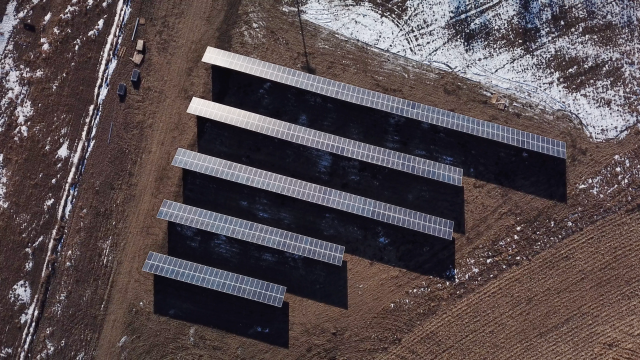In 2016, the Standing Rock Sioux Tribe launched a battle against an oil pipeline running across their ancestral lands. Despite their efforts gaining international attention, the 1886km-long Dakota Access Pipeline was built anyway. The tribe lost that battle — but its members didn’t let that defeat stop them from tackling the greater issue at hand: Climate change.
Tribal members, alongside celebrities who joined the protests in 2016 such as Mark Ruffalo (The Avengers) and Shailene Woodley (Big Little Lies) and Rep Tulsi Gabbard (D-Hawaii), are celebrating North Dakota’s first solar farm this week, which is also located on the tribal reservation.
The CannonBall Community Solar Farm adds 300 kilowatts into the grid, which might not sound a lot, but it is for this community. Plus, it brings the tribe one step closer to ending its dependence on fossil fuels, which are driving the climate crisis.
[referenced url=”https://gizmodo.com.au/2019/06/closing-the-wests-largest-coal-plant-will-leave-the-navajo-nation-with-58-million-in-missing-revenue/” thumb=”https://i.kinja-img.com/gawker-media/image/upload/t_ku-large/hjs88nuoejdm3sagwgwq.jpg” title=”Closing The West’s Largest Coal Plant Will Leave The Navajo Nation With $58 Million In Missing Revenue” excerpt=”The Navajo Generating Station in Arizona is closing, and that’s terrible news for the Native American communities that rely on the coal plant for their income. A new report from the Institute for Energy Economics and Financial Analysis (IEEFA) is calling on the US federal government to step in for this major economic disruption the Navajo Nation and Hopi Tribe are preparing to face.”]
The solar farm will save the community $US7000 ($10,133) to $US10,000 ($14,476) annually in energy costs.
This money will go back into the community with the hopes of creating a scholarship program to help protect their native Lakota language, said Hayes Baynard, the CEO of GivePower, one of the nonprofits that is partnering on the project and invested $US370,000 ($535,612) in it. The farm’s total cost was $US470,000 ($680,372).
While nonprofits such as GivePower, Empowered by Light and Jinko Solar helped fund this project, the idea belongs to Cody Two Bears, the executive director of Indigenized Energy and former Standing Rock tribal council member.
He reached out to a few of these groups during the height of the Standing Rock mobilisation because he saw solar energy as the best way to combat this pipeline and the greater fossil fuel industry.
“I never thought that pipelines would come in my backyard. I never thought that fossil fuels would affect my community or affect our people, our sacred sites, our water, our lands — and devastate them,” Two Bears told us. “It’s one thing to protest about it, to talk about it, but now we got to be about it.”
The solar farm connected to the grid back in February, but it won’t go live until August.
When it does, it’ll power the Cannonball Youth Activity Center where community events are held — and where the public came to take showers and eat during the Standing Rock protests — and it’ll power the Veterans Memorial Building where thousands of veterans who came out to support the pipeline opponents stayed in 2016.
The new project truly has roots where these efforts first began.
“So what better way to actually help offset the very first phase one? Those two buildings because they played a key role in the movement, as well, to helping a lot of people and housing people and feeding people,” Two Bears said.
Interest in renewable energy has been growing across Native American communities in the US.
The Navajo Nation, which is dealing with the closure of a coal plant that fuelled much of its income, has set its eyes on solar instead. The Navajo Nation is gearing up to build its third solar farm.
The Moapa Band of Paiutes in Nevada, another community previously dependent on the coal industry, signed an agreement last month for a new solar farm and storage system. The tribe was the first to build a utility-scale solar project on tribal lands.
“It’s pretty amazing that we see indigenous communities adopting renewable energy from coast to coast,” said Melina Laboucan-Massimo, who studies climate change, renewables and indigenous knowledge as a fellow for the David Suzuki Foundation, to us.
“For me, as an indigenous person, it’s also a lot more in alignment with our indigenous worldview and philosophy about reciprocity and connection to the Earth and ensuring we protect the Earth, we protect the water, the land.”
Two Bears has plans to expand solar on the reservation beyond what the farm currently offers. Eventually, Indigenized Energy will be running the farm all on its own without the help of its partners. Two Bears now has the training and knowledge to install panels throughout the tribal nation and the state.
He wants to see solar panels on homes, too. That’s the ultimate goal, but that might be a while as current regulations don’t allow panels on government-issued homes, which most are on the reservation, Two Bears said. In the meantime, he hopes to add solar panels to schools and public service buildings. He expects the second phase to begin later this year.
What’s happening in Standing Rock is a dramatic departure from North Dakota’s current energy scene. The state is the second highest producer of crude oil. While wind energy is expanding, the state hasn’t yet tapped into its solar potential, according to the Energy Information Administration.
Standing Rock won’t wait for other leaders to take charge. It’s changing the game.
